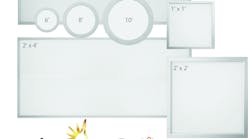Download a PDF version of this article (250 KB)
White LEDs are widely used today in handheld devices, such as cellular phones, as backlights for color liquid-crystal display (LCD) screens or to light up keypads. Colored LEDs, notably blue and green, are also used for such purposes and in addition are good indicators for reporting to the user an incoming call or a charging battery.
LED brightness is proportional to the amount of current flowing through the device. Also, the voltage must be high enough to turn the device on. The most popular batteries today are lithium-ion based, where the voltage is typically around 3.6 V but drops as the battery discharges. For these reasons, LEDs cannot be powered directly from the battery, and a regulated boost converter is needed. Regulated charge pump solutions are very popular especially in applications where the total output current is less than 100 mA, due to their simplicity and low cost.
Driving LEDs with different currents
Regulated output charge pumps, for example the CAT3200-5 from Catalyst Semiconductor, are ideal for driving LEDs in parallel and are capable of delivering up to 100 mA load current with an output voltage (Vout) fixed at 5 V.
A good approximation of the LED current is given by the following equation where interconnection losses are neglected:
Output voltage = LED forward voltage + (LED current x ballast resistance)
Vout = VF + (ILED x Rs)
With the output voltage (Vout) fixed at 5V, a 20 mA LED with VF = 3.4V requires a ballast resistor of Rs = 80 Ohm.
In the example in figure 1, three white LEDs are used for the backlight and two color LEDs, red and blue, are used as indicators. Each colored LED has forward voltage characteristics that are different from each other and from the white LEDs. The red LED has a much lower VF, typically 2.8 V at 20 mA. Since their function is not lighting, indicator LEDs run on a lower current than the white backlight LEDs, and therefore require a larger ballast resistance.
The CAT3200-5 charge pump is a voltage doubler that only requires a single bucket capacitor used as reservoir to transfer charge from the input to the output. A 1 µF ceramic capacitor is recommended. Two additional 1 µF capacitors on the input and output pins are the only other necessary external components.
Other approaches
Other LED driver implementations are available, such as inductive boosts or current regulated charge pumps.
The inductive boost driver uses an inductor to boost the input voltage to a high voltage, allowing several LEDs to be driven in series. This has the advantage of providing the same current in the LEDs, but this configuration is not applicable to our example.
Inrush current
With the configuration shown in figure 1, a critical aspect occurs when the system powers up. When the device turns on and starts charging the bucket capacitor, a significant increase in the input current is seen over a short time period, causing what is referred to as "inrush" current.
One figure of merit of a power management solution is how it controls this input current. The risk with high inrush current is that it will cause a momentary drop in the internal rail voltage which can affect the system operation and cause it to crash.
A way to reduce the inrush current pulled out of the battery is to increase the size of the input capacitor. That way, a larger fraction of the current required to fill the bucket capacitor is provided by the input capacitor, reducing the inrush current. Figure 3 shows the input current and output voltage waveforms for 1 µF and 4.75 µF input capacitors used with the CAT3200.
Conclusion
Regulated charge pumps offer good solutions for driving LEDs and are easy to implement on a PCB. When selecting a device, some key parameters to look at are the output current capability, the input voltage range, the power-up sequence, the switching frequency and the low noise operation.








